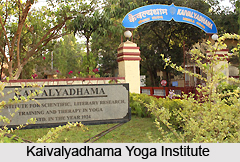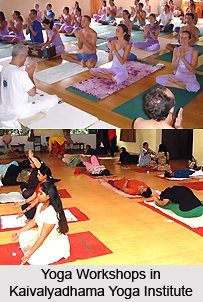
Kaivalyadhama Yoga Institute is located at Lonavala, Maharasthra. It is an institute that was established by the aid of Government of India, Ministry of HRD & Government of Maharashtra, Department of Higher and Technical Education. Kaivalyadhama Yoga Institute is recognized by University of Pune for research, Council for Scientific & Industrial Research, Government of India and National Council for Teacher Education, Government of India gave this institute a permanent recognition. It was declared as an Institute of Higher Learning by Government of India, Ministry of Education in 1962. Kaivalyadhama Yoga Institute was recognized by Government of Maharastra to give fourteen days on duty leave to its employees. It was also declared as resource centre or Nodal agency in context with `Introduction of Yoga in Schools` by Ministry of HRD, Department of Education.
The Kaivalyadhama Yoga Institute was established with the goal of restructuring the society according to the spiritual values and through revival of ancient Yogic discipline. Swami Kuvalayananda established the Kaivalyadhama Yoga institute on the Vijaya Dashami Day on 1924, at Lonavala of Maharashtra. Soon a number of talented workers who were devoted to Yoga gathered around Swami Kuvalayananda. He also started publishing the journal `Yoga Mimansa`, which revealed his researches and scientific work to unravel the mysteries of Yoga.
As the work expanded in Kaivalyadhama Yoga Institute a new offshoot was established, called `Shriman Madhav Yoga Mandir Samiti` to look after the research section. As the Institute soon earned worldwide fame a large number of young trainee started learning Yoga at the Ashram. To train them properly in Yogic physical culture, another institute was opened in 1950 named `Goradhandas Seksaria College of Yoga & Cultural Synthesis. Also a number of patients suffering from psychosomatic diseases used to visit the Kaivalyadhama Yoga Institute. For them the `Rugna Seva Mandir` was created. This soon inspired the establishment of ` Shrimati Amolak Devi Tirtharam Gupta Yogic Hospital` to look after the patients of chronic functional disorders through Yoga. This was the first of this kind of hospital in India, established in 1961. The demand arose to spread the activity and new branches were set up in Mumbai, Rajkot, Delhi, Bhopal and USA & France. The excellent work of Kuvalayananda drew the attention of national leaders like Mahatma Gandhi, Pandit Madan Mohan Malavya, Pandit Jawharlal Nehru.
 Swami Kuvalayananda was the founder of Kaivalyadhama Yoga Institute. He made popular the ancient form of Yoga to the modern men of India through his scientific research. Thus he could make the yoga more widely acceptable and accessible in the field of health healing. Swami Kuvalayananda was born on 30th August of 1883. It was the time when there was resurgence of patriotism throughout the India. In his college days swami Kuvalayanda came under the influence of Sri Aurobindo and after graduating from college he joined Lokmanya Tilak`s Home-rule movement. Swami Kuvalayananda always thought the way of freedom of Indian masses, who were ignorant, illiterate, superstitious and sick in spirit and body. He understood that education could bring light to their lives. He joined the Khandesh Education Society of Amalner, where he ultimately became the Principal of the National College in 1916. Swami Kuvalayananda was accustomed with yoga as India`s physical culture as he came under the influence of Jummadada Vayamshala at Baroda and its mentor Rajaratna Manikrao. The exposure of Yoga opened a new prospect for him. He was enthusiastic with the physical as well as psycho-spiritual prospect of Yoga. Kuvalayananda got the guidance of great Yogin of Bengal Paramhansa Madhavdasji, who had settled at Malsar, near Baroda, on the Banks of Narmada. After this Swami Kuvalayananda`s career took a sharp turn and he came in the way of yoga. He tried to investigate the effects of Yoga with some of his students, in the laboratory of Baroda Hospital, in 1920-21. After that his life`s mission was the spiritual and material resurgence of human society through Yoga.
Swami Kuvalayananda was the founder of Kaivalyadhama Yoga Institute. He made popular the ancient form of Yoga to the modern men of India through his scientific research. Thus he could make the yoga more widely acceptable and accessible in the field of health healing. Swami Kuvalayananda was born on 30th August of 1883. It was the time when there was resurgence of patriotism throughout the India. In his college days swami Kuvalayanda came under the influence of Sri Aurobindo and after graduating from college he joined Lokmanya Tilak`s Home-rule movement. Swami Kuvalayananda always thought the way of freedom of Indian masses, who were ignorant, illiterate, superstitious and sick in spirit and body. He understood that education could bring light to their lives. He joined the Khandesh Education Society of Amalner, where he ultimately became the Principal of the National College in 1916. Swami Kuvalayananda was accustomed with yoga as India`s physical culture as he came under the influence of Jummadada Vayamshala at Baroda and its mentor Rajaratna Manikrao. The exposure of Yoga opened a new prospect for him. He was enthusiastic with the physical as well as psycho-spiritual prospect of Yoga. Kuvalayananda got the guidance of great Yogin of Bengal Paramhansa Madhavdasji, who had settled at Malsar, near Baroda, on the Banks of Narmada. After this Swami Kuvalayananda`s career took a sharp turn and he came in the way of yoga. He tried to investigate the effects of Yoga with some of his students, in the laboratory of Baroda Hospital, in 1920-21. After that his life`s mission was the spiritual and material resurgence of human society through Yoga.
There are many Departments in Kaivalyadhama Yoga Institute- the Scientific Research Department, yogic health care center, Ashram, philosophico-literary research in Yoga, Goradhandas Seksaria College of Yoga& Cultural Synthesis. The Scientific Research Department has five sections- Physiology section, Biochemistry section, Psychology section, Physical Education Section, Neuro-Psychology section. The researches were done on Asanas, Kriyas, Pranayama and `Aum` recitation, yoga training, yoga therapy, special projects, future research plans, research based courses, research recognition and collaborative research, benefits of yoga practices. The Ashrama is a center where special classes are taken for Pranayama. There are two ways of learning- Swadhyaya and Ishwarpranidhan. The ashram follows the old Hindu tradition and contains one Gaushala even, which have around 200 cattle. The milk of the cows is distributed among the students. The Philosophico literary research center involves basic work and analytical work. Gordhandas College of Yoga and Cultural synthesis was formed from the donation of Seth Makhanlala seksaria and was named after his father Seth Gordhandas Seksaria. The college offers various courses ranging from certification courses and diploma to M. Phil and Ph D. Scholarship program for foreign students is also available. The Yojic Health Care Center offers yoga therapy and other naturopathy.
It will not be exaggeration if one says that scientific Yoga is the single largest contribution of Swami Kuvalayananda and the Kaivalyadhama is the manifestation of his thoughts. When Swamiji set about his quest about perfection in Yoga he was aware that it would not be easy to attain the perfection. Kaivalyadhama is not claimed as hose of perfection but there is no imperfection also. Kaivalyadhama Yoga Institute has crossed Seventy-five long years of existence and is recognized as the great landmark in its own way in the field of Indian culture of yoga. The name of Kaivalyadhama Yoga Institute is enough to reveal its introduction and activity.




















